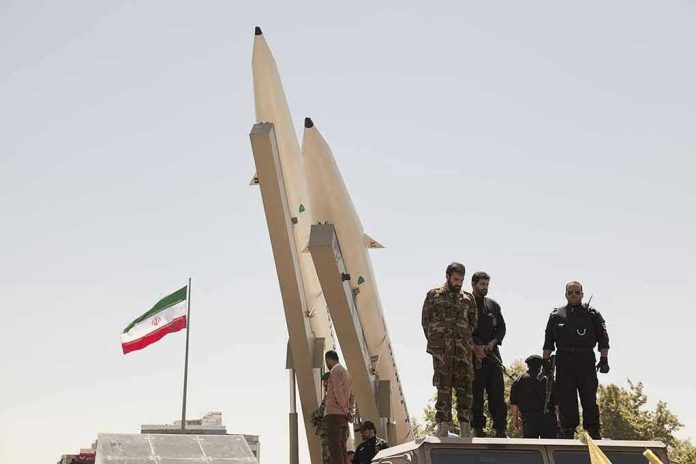
A single missile parade in Tehran has done more to rewrite the rules of Middle East deterrence than a decade of shadow warfare—raising the question: what happens when a nation’s arsenal is put on display for the world to see, right after a war?
Story Snapshot
- Iran’s first public exhibition of ballistic missiles and advanced drones comes immediately after direct conflict with Israel.
- The event features the debut of the Shahed-116 drone and signals a new phase in Iran’s military strategy.
- Foreign-supplied components in Iranian drones highlight the complexities of international arms control.
- Regional powers and the U.S. respond with heightened vigilance and fresh sanctions, fueling an ongoing arms race.
Iran’s Arsenal Steps Into the Spotlight After War With Israel
November 2025, Tehran: Iran’s sprawling military parade ground transforms into a theater of power, as the Islamic Republic unveils its most advanced ballistic missiles and drones—including the Shahed-116. The timing is unmistakable: just months after a direct military clash with Israel, Iranian leaders make a calculated decision to display strategic weapons previously shrouded in secrecy. This is not mere bravado—it is a message, both to adversaries and to wary onlookers, that Iran’s deterrence doctrine has entered a new, more public phase.
Missiles glisten under the sun, flanked by ranks of Shahed drones, while the world’s cameras roll. Officials, led by Supreme Leader Ali Khamenei and the IRGC top brass, deliver speeches that frame the display as a warning: Iran’s military might is not theoretical. It is operational, it is homegrown, and, as subsequent revelations suggest, it is partially constructed with foreign-supplied components. For decades, Iran’s missile and drone programs grew in the shadows, spurred by sanctions and the belief that conventional parity with Israel or the U.S. was out of reach. Now, the curtain is pulled back, and the weapons are center stage.
Decades of Proxy War Give Way to Open Confrontation—and Calculated Signaling
For years, Iran and Israel clashed through proxies across Lebanon, Syria, and Gaza—a shadow conflict that allowed both sides to project power while avoiding direct escalation. In April 2025, that uneasy equilibrium shattered. Missiles and drones crisscrossed borders, targeting infrastructure and military assets. The fighting was short but transformative. By May, a ceasefire took hold, but a new regional reality had emerged: deterrence would now be measured not just in capabilities, but in the willingness to show them off. Iran’s November display answers that call, reframing the postwar narrative and challenging adversaries to recalibrate their own response.
The involvement of foreign-supplied components in Iran’s drone fleet, revealed by independent investigators and confirmed by Western officials, adds another layer of intrigue. Ukrainian-sourced electronics and dual-use parts, reportedly found in the Shahed-116, point to the porousness of global technology supply chains. While Washington responds with a fresh wave of Treasury sanctions targeting companies tied to Iran’s drone program, Iranian officials dismiss the measures as futile, vowing to accelerate weapons development despite international scrutiny.
Stakeholders Respond: Regional Arms Race Intensifies, Political Calculus Shifts
The parade reverberates far beyond Tehran. In Jerusalem, Israeli defense planners redouble efforts to upgrade missile defenses and expand intelligence operations targeting Iranian supply routes. The United States, already enmeshed in the region’s security architecture, doubles down on sanctions and signals unwavering support for Israeli security. Gulf states, caught between the regional giants, weigh the risks of further escalation, even as their own defense budgets swell in anticipation of a new arms race.
Inside Iran, the public display is broadcast as a triumph of sovereignty and technological prowess. State media trumpet the message that domestic innovation—bolstered, when necessary, by covert foreign procurement—has rendered the nation’s deterrent unassailable. Yet, among reformist circles and the global diplomatic community, concerns mount over the normalization of military brinkmanship and the risk that advanced drones and missiles will proliferate to non-state actors across the region.
Long-Term Implications: Deterrence, Escalation, and the Future of Arms Control
The immediate aftermath of Iran’s missile and drone showcase is clear: a surge in regional tensions, new rounds of sanctions, and a race to field more sophisticated countermeasures. Over the long term, however, the event may prove even more consequential. By making its arsenal visible, Iran not only signals resolve but also speeds up an arms buildup among rivals and proxies alike. The defense industry pivots toward counter-drone and missile defense technologies, while international watchdogs scramble to track the flow of sensitive components.
For American conservatives and advocates of robust deterrence, the episode underscores two realities: first, sanctions and export controls—while necessary—are not sufficient to halt determined adversaries. Second, transparency in military capabilities can be as destabilizing as secrecy. The world is now forced to grapple with a Middle East where advanced weaponry is not just developed but openly displayed, blurring the line between deterrence and provocation. As debates rage over how best to contain Iran’s ambitions, one fact is inescapable: the rules of the regional game have changed, and the world is watching what happens next.
Sources:
Media coverage of Iran’s military showcase and foreign-supplied drone components













